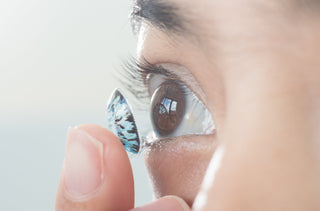Our eyes are biological marvels. In a fraction of a second, they capture light, transform it into electrical signals and send them to the brain, which interprets them into clear, colourful images. Behind this apparently simple process lies a fascinating and complex science.
How does vision work? Vision begins when light enters the eye through the cornea, the transparent surface at the front of the eye. It then passes through the pupil, whose diameter is regulated by the iris, then through the crystalline lens, which adjusts its shape to focus on objects near or far. The image is then projected onto the retina, a thin layer of light-sensitive cells at the back of the eye.
The retina contains two types of photoreceptors:
- Cones, responsible for colour vision and high resolution.
- Rods, sensitive to faint light and essential for night vision.
The signals picked up by these cells are sent to the optic nerve, which transmits them to the brain, mainly to the visual cortex at the back of the head. The brain then reconstructs a coherent image from this information.
Main eye disorders: Understanding vision disorders also means understanding how the various structures of the eye can be affected:
- Myopia, hyperopia and astigmatism: These are refractive errors caused by an abnormal shape of the eye or lens. They cause blurred vision at near and far distances.
- Presbyopia: Linked to aging of the crystalline lens, it makes reading difficult with age.
- Cataract: Opacification of the crystalline lens, causing blurred vision, usually treated by surgery.
- Glaucoma: A disease of the optic nerve, often linked to high intraocular pressure, which can lead to irreversible vision loss.
- Age-related macular degeneration (AMD): Affects the macula, the central area of the retina responsible for fine vision.
- Dry eye syndrome: often caused by insufficient tear production or rapid evaporation.
Eye health is influenced by many factors:
- Age: Certain conditions are more common with advancing age.
- Genetics: Some eye diseases are hereditary.
- Lifestyle: A nutrient-poor diet, smoking, excessive exposure to screens or UV rays can all be detrimental to eye health.
- Systemic diseases: Diabetes, hypertension or autoimmune diseases can have a direct impact on vision.
Tips for preserving your vision: Fortunately, there are several ways to take care of your eyes on a daily basis:
- Consult your optometrist regularly for a complete eye examination, even if there are no apparent symptoms.
- Eat a diet rich in antioxidants, omega-3s and vitamins A, C and E (fruit, green vegetables, oily fish, nuts).
- Protect your eyes from the sun with UV-filtering sunglasses.
- Take breaks when using screens: the 20-20-20 rule (every 20 minutes, look 20 feet away for 20 seconds).
- Stay well hydrated and avoid overly dry environments.
- Quit smoking, an aggravating factor in many eye diseases.
The science of vision is an exciting field that reminds us just how precious our eye health is. By understanding how our visual system works and adopting good habits, we can preserve our vision and enjoy the world around us.
Make an appointment with your IRIS optometrist today to keep your eye health in optimal condition. Your eyes will thank you!





















































